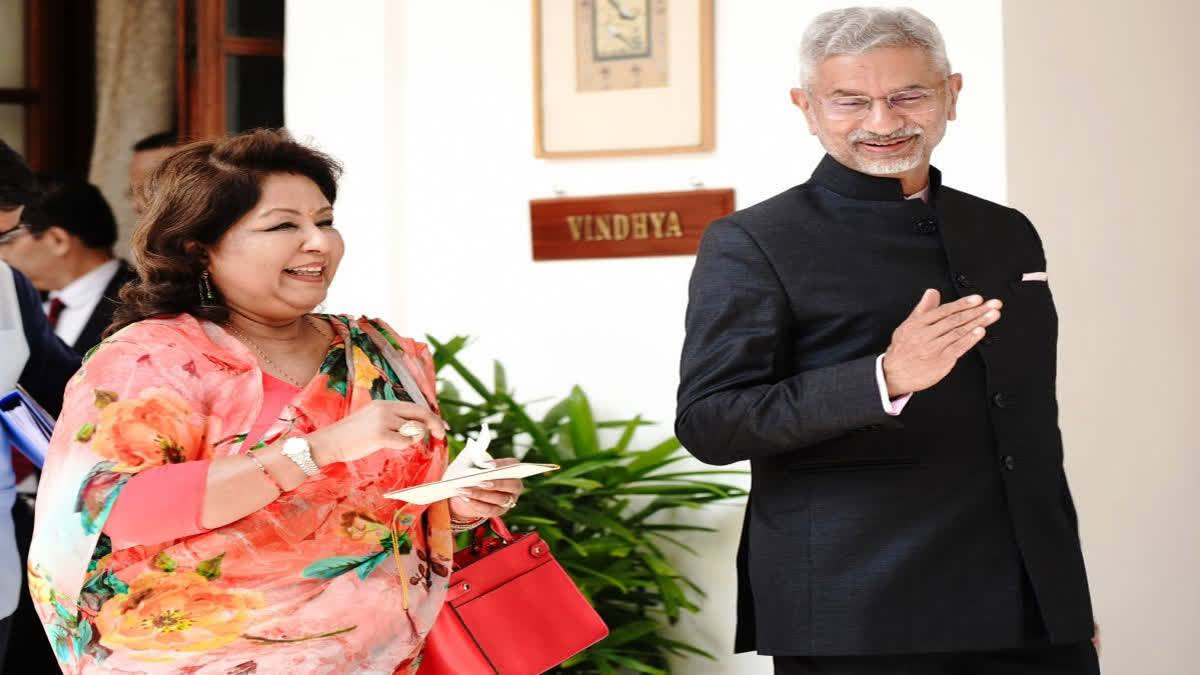New Delhi: A new chapter in India-Nepal trade relations is on the horizon as the proposed Dodhara Chandani dry port in Nepal’s far-western region promises to revolutionise cross-border connectivity.
With the Indian public sector undertaking RITES issuing a tender earlier this month for the Rs 2.54-billion project, work on it is expected to start as early as April this year. The project completion period has been set at 30 months.
Set to become a major logistical hub, this dry port will streamline the movement of goods between Nepal and India, significantly reducing transit time and costs. As both nations strengthen their economic ties, the dry port represents a gamechanger, offering enhanced trade opportunities, regional integration, and crucial infrastructure for Nepal, a landlocked country long dependent on India's ports.
When completed, this will be the fourth dry port along the India-Nepal border after Raxaul, Rupaidiha and Jogbani. As of now, Nepal’s trade connectivity with the rest of the world is mostly concentrated towards the east with access to the Kolkata port. Once operational, the Dodhara Chandani dry port will give the landlocked Himalayan nation access to the Jawaharlal Nehru Port in Mumbai.
According to Ashish Gajurel, executive director of the Nepal Intermodal Transport Development Board, the tender process moved forward following a series of discussions held at the Indian Embassy in Kathmandu. In these discussions, the Nepali side committed to clearing trees by April.
"We plan to start the works on the ground in April," the Kathmandu Post quoted Gajurel as saying. “We are working on clearing the land to hand it to the Indian construction company."
According to the Post report, the scope of work includes constructing the administrative building, warehouse, quarantine facilities, and residential buildings. India will also construct a link road from the Indian national highway to the dry port. Nepal has listed the dry port as a national priority project.
The dry port is expected to enhance the efficiency of cargo handling and customs clearance, reducing transit time and costs. Currently, Nepal uses the Kolkata port and other Indian ports, but the Dodhara Chandani dry port, strategically located in the western region, offers a more direct and time-efficient route for both Nepal and India.
It will streamline trade flows between Nepal and India by serving as a logistics hub for the movement of goods. The dry port will offer facilities such as warehousing, cargo handling, and customs processing, which will encourage smoother and faster trade transactions.
With better connectivity, Nepal will have enhanced access not only to Indian markets but also to international markets, making its goods more competitive. This will boost Nepal’s exports, especially agricultural products, handicrafts, textiles, and minerals, to global markets.
According to Ranjit Rae, former Indian Ambassador to Nepal, Dodhara Chandani is on the south bank of the Mahakali River in the Sudurpaschim province of the Himalayan nation and the Nepali side was keen to have two things.
"One was to have a bridge across the Mahakali River," Rae told ETV Bharat. "The other was to have a dry dock."
The bridge is now complete and an eight-km road linking the site for the proposed dry port is in its final phase. Rae explained that Sudurpaschim province is one of the poorest regions in Nepal.
"Once the dry port becomes operational, it will boost economic development both in Nepal’s Sudurpaschim province and India's Uttarakhand state," he said. "It will help the flow of goods between north India and Nepal's western region."
The establishment of the Dodhara Chandani dry port is expected to contribute to Nepal's economic growth in several ways. The construction and operation of the dry port will generate thousands of jobs, both directly and indirectly. This will benefit the local population in Nepal’s far western region, which currently suffers from high unemployment and limited economic opportunities.
The dry port will be accompanied by investments in infrastructure, including roadways, railways, and possibly even air connectivity. This will further improve the region’s accessibility and contribute to the overall development of the area.
Citing the master plan for the project, the Post report stated that the depot will eventually accommodate 3,000 20-foot freight trucks, though the first phase will provide space for 300 trucks. The import warehouse will have a 7,000 square-metre space, and the export warehouse will cover 2,520 square metres. Similarly, a railway warehouse will occupy 17,500 square metres, and the container stacking yard, a large open space for container movement, will be built over 10,000 square metres.
The Dodhara Chandani is expected to improve connectivity not just between Nepal and India but also within Nepal's domestic transportation network.
The dry port will be connected to the Indian highway and railway systems, which will make the transportation of goods between Nepal, India, and beyond more efficient. It can act as a critical link for the trade routes connecting various parts of South Asia, especially with the ongoing infrastructural developments like the India-Nepal cross-border railway.
"The enhanced connectivity will not only boost trade but also people-to-people contacts and tourism," Rae said. "Now, it will be an easy drive of six-seven hours from Mahendranagar in Sudurpaschim province to Delhi." It is worth mentioning here that Dodhara Chandani is just 245 km from Delhi and 1,200 km from Gujarat.
Rae also said that along with the completion of the bridge and start of the work on the Dodhara Chandani dry port, India and Nepal should also finalise the Pancheswar Multipurpose Project, a joint hydropower project on the Mahakali River.
India and Nepal had signed a treaty known as Mahakali Treaty in February 1996. Implementation of Pancheshwar Multipurpose Project is the centrepiece of the Mahakali Treaty. Required field investigations for the project were completed by a Joint Project Office in 2002. But mutually acceptable detailed project report (DPR) of Pancheshwar Project could not be finalised due to differences on certain contentious issues.
"The bridge, the dry port and the Pancheswar project should be seen as one whole," Rae stressed. "The Mahakali River should be seen as a linking medium between India and Nepal and can help resolve several political issues."
From a geopolitical standpoint, the Dodhara Chandani dry port holds great significance for both Nepal and India. For Nepal, this project represents a chance to enhance its autonomy in managing cross-border trade.
The dry port can be a symbol of growing cooperation between India and Nepal, improving bilateral ties. It also reflects India's commitment to facilitating Nepal's economic development. India's strategic interests in ensuring the smooth transit of goods through the port can lead to strengthened diplomatic and economic relations.
With increasing global trade and China's growing influence in South Asia, enhancing connectivity and improving trade infrastructure between India and Nepal could help reduce Nepal’s reliance on Chinese trade routes, especially the one via Tibet. The Dodhara Chandani dry port, therefore, offers a way to bolster Nepal’s trade position within the context of South Asian geopolitics.
To sum up, the Dodhara Chandani dry port is a game-changing infrastructure project with immense potential to transform trade and connectivity between Nepal and India. By boosting trade efficiency, fostering economic growth, and promoting regional integration, the dry port stands to enhance Nepal’s access to global markets and increase India’s role as a regional trade hub.



